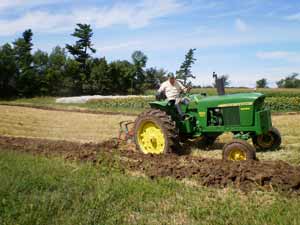August 19, 2010; Alburgh, Vermont. Roger Rainville has been a dairy farmer all his life. 5 years ago, on Borderview Farm, Rainville sold off all his dairy cows, about 120 of them, and now raises 50 replacement cows. He has also converted his 300 acre farm into becoming a research farm, with over 3000 test plots active today. Biodiesel is an important part of his ongoing research efforts.
One of Rainville’s goals was to produce enough of his own biodiesel from growing canola and sunflower crops to cost effectively fuel his farm. Rainville has worked diligently for several years to perfect just the right methods for growing his biodiesel crops, and to extend those crops for other economic uses.
He points out, for a $20,000 investment, a 400 acre farm can put in a processing facility to make all of their own diesel fuel. Although seed loss can occur, especially with canola seed that’s finicky when it comes to storage, there’s a fairly inexpensive overhead to running a processing facility. Rainville had 2 excellent seasons with his sunflower crop, producing 2000 pounds per acre, almost half of that in oil. He expects to continue to produce between 80-125 gallons of oil per acre on his farm.
He is using the same land base for the production of fuel that was used 100 years ago. The difference today, instead of crops grown to feed draft horses, the crops he grows, feeds his five tractors through the active farming months, consuming between 1500-2000 gallons of fuel.
Stay tuned for much more to come about Roger Rainville, and his farm, on CUpS!


